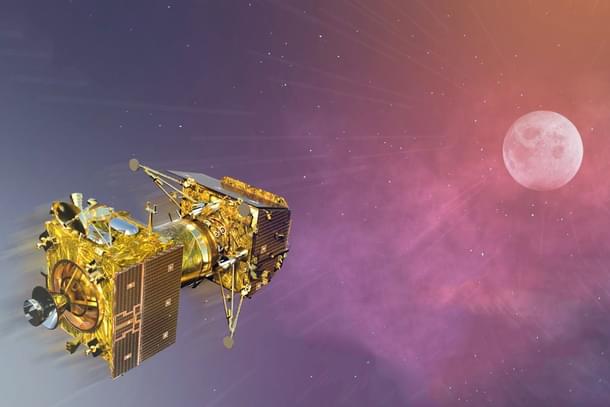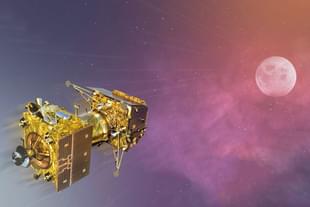Science
Chandrayaan-2 Is Progress Because Science Builds On Its Failures
Vikas Saraswat
Sep 10, 2019, 01:31 PM | Updated 01:31 PM IST
Save & read from anywhere!
Bookmark stories for easy access on any device or the Swarajya app.


Magic excites but science amazes. Magic excites because it defies our intuitive and logical expectations. The pursuit of science, on the other hand, is a structured exercise so gradual and sublime that it doesn't arouse instantaneous thrill.
Nonetheless, it keeps amazing us when scientific phenomena reveal the seemingly obvious around us in various laws of nature, theories and postulates. The advance in technology adds zing to the game.
Acclaimed fiction writer Arthur C Clarke, who also co-wrote the screenplay of 2001: The Space Odyssey said: “Any sufficiently advanced technology is indistinguishable from magic”. Where else would the words be truer than in the field of space exploration, which prompted Clarke to remark the same.
Among the various scientific inquiries humanity has embarked upon, the most bewildering have been in the realm of space. The enormity of time and distances boggle the mind.
They also puncture our anthropocentric ego. In our spirit of inquisitiveness, the profound significance of space science for human existence is captured poetically by British cosmologist Martin Rees.
He says: “We owe our existence to stars, because they make the atoms of which we are formed. So if you are romantic, you can say we are literally starstuff. If you’re less romantic, you can say we’re the nuclear waste from the fuel that makes stars shine”.
For us humans on earth whom Rees imaginatively calls “ashes of long dead stars”, ISRO’s mission Chandrayaan 2 was a visit planned to our closest celestial relative during the course of a business tour.
Naturally, there was an air of expectancy and much fanfare. The events turned out to be a little different than the plan. Though business on the trip continues unhindered, the visit, for some time, appeared to be aborted.
A later development confirmed that there was contact with the relative but no private communication. Understandably, there has been disappointment. We had hoped for a tete-a-tete but will now have to contend with field reports which will later need to be summarised.
From the question of life to the mystery of cosmic creation and forces determining the laws of the universe, astrophysics has all in its womb. These questions fascinate not just scientists or physicists but thinkers, philosophers and theologians alike.
Amusingly, various theologies compete with each other to prove theirs as the most scientific. Doubt it or revel in it, challenge or co-opt it, but none could avoid being struck by the wonder of science.
Popular science, as a genre of writing, quite deservedly heroised the scientists and romanticised their forays. In the process, however, a lot was spiced up too. The fall of apple in Newton’s garden was not a ‘Eureka’ moment.
He had tediously observed the phenomena over and over to form his idea on gravity. Similarly, Darwin didn't hit upon the theory of natural selection on Galapagos Islands but several years later, after his return to England. And there is no contemporary source to confirm if Niels Bohr had indeed nailed a horse shoe to his door.
This juicing up to romanticise science is a minor transgression. The bigger and more serious issue is the removal of failures from history of popular science. The fear being that of the glamour quotient getting affected.
Failure stories and crazy ideas in science rob the heros of their sheen. The “great” scientists are rendered humane. Nevertheless, failures in science far outnumber the successes.
The reason is simple — the territory of fresh theorising and experimental confirmation of theories is mostly uncharted. As progress in science builds also on its failures, it will be instructive if we acquainted ourselves with a peculiar character in the history of science.
In his fascinating book The Age of Wonder which chronicles the Romantic age of science, Richard Holmes profiles about half a dozen geniuses. One chapter in the book is titled “Herschel On the Moon”.
William Herschel, like many of the polymaths (the term scientist wasn't coined by then; it was coined only in 1833 by William Whewell) of his age was born in 1738 in Hanover, which was part of the Holy Roman Empire at that time.
Born in a family of musicians, teenaged Herschel followed his father's footsteps and joined the Hanover Military Band. At the age of 19, circumstances forced him along with one of his elder brothers, to leave for Great Britain where he excelled as a musician playing in churches, writing symphonies and conducting concerts.
Music finally led Herschel to astronomy when, after finishing mathematician Robert Smith's Harmonics: The Philosophy of Sounds he picked up Smith's other book A Complete System of Opticks.
A romance was kindled which would change the human understanding of space forever. It would also earn Herschel a place in the history of science.
Frederick William Herschel, an Oboist and Organist, who pursued astronomy as a passion would be the first person to spot Uranus. The discovery of infrared radiations would be credited to him.
Some 800 double stars were waiting for this illustrious progeny to rise from their ashes in a far off habitat and recognise them. He corrected the rotation period of Mars and catalogued 2,400 celestial objects marking them as nebulae (During Herschel's time, any dispersed celestial object beyond the milky way was called nebula; a conception corrected over the period of time).
Herschel spotted two of Saturn's natural satellites. His success in making “front view” reflector telescopes revolutionised the field of astronomy. The resulting enterprise, which was a huge commercial success, turned him into an inventor as well.
But what was Herschel's moon connection which prompted Holmes to title his chapter on him with reference to it? Quite comical in fact, when we see it with the benefit of progress in astronomy since his times.
Sir William Herschel believed there was life on moon which was much like the English countryside. For evidence, he cited the presence of forests on moon's mountains. He reasoned that since moon received more reflected light from earth in addition to direct light from Sun, it had the possibility of even more evolved life. The craters on moon's surface were, according to Herschel, artificially created by “lunarians” to harness more light.
To be fair to him, Herschel wasn't the first person to articulate the idea of life on moon. There were others before him but then none of them was the first President of the Royal AstronomIcal Society.
He proposed life on Mars; and in one of his papers, an even more crazier idea claiming the possibility of life on pockets of Sun. It is amusing to note that a man regarded highly for his deep sky surveys was getting it horribly wrong in our immediate neighbourhood.
But what if Herschel were to suddenly wake up from hibernation and know of ISRO's Chandrayaan 2 project? His first instinct would have received the affair as magic. Then gradually the science of it, even if unintelligible in its comprehensiveness, would have dawned upon him.
Any which way, Herschel would have been immensely proud of the mission and advance which humanity has made in space science.





